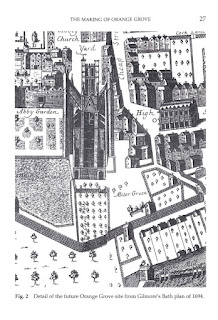Most of you are probably going to find this post a bit boring, but that is maybe what we need at the moment.
I have always known that the gaudy facade of Orange Grove hides a much earlier building, but I was looking at it closely the other day before I took this video. I don't know why I have not consciously noticed this before, but here is the evidence that whoever decided to improve the architecture, simply stuck on a frontage which was more to their taste and - in their opinion - more in keeping with the theatrical grandeur of Bath.
The Georgians often 'Georgianised' earlier building using this method. The gabled fronts of charming 17th century buildings were often obliterated by glueing on 18 inches of plain ashlar, but the configuration of the windows gives away the original design. The Bell Inn and the Crystal Palace pubs were given this treatment. It was cheaper than a new build.
The Orange Grove block looks as though it was tarted-up in the 19th century to me, possibly at the same time they were tarting-up the Abbey which overshadows it. The iron gutter hopper has the date 1705 written into it. The Georgians would not have been so candid about the origins.
UPDATE: I have just read everything there is to know about the making of Orange Grove -(including the names of every trader and interested party since the mid 17th century!) by reading a truly comprehensive paper of the same name by Trevor Fawcett and Marta Inskip. I eventually got to the part where they explain that the building was re-fronted between 1893 and 1901. So I was not far out.
Here's another update from the paper. Note the formal garden in Abbey Square!
And yet another. See what remains of the two original pillars of the left-hand door of the Abbey as seen in the above map. How things change - including ground-levels.



Fascinating! No, really I am not being sarcastic it really is interesting
ReplyDeleteHa ha!
DeleteHmm..what sort of Ha Ha is that?! Didn't Pooh and Piglet have a conversation about that?🙂
DeleteYes, buildings ARE interesting and can tell us a lot about our and their history.
Facing is very common. Isn't it a low cost fix? It is sad when the fix is not even close to historically correct. A neighbor installed stacked stone against a 3-story tall exposed brick fireplace and it looks massive and dreadful. The contractor advised against it. There is no accounting for taste.
ReplyDeleteA 3 story tall fireplace? Do you mean an external stack?
DeleteThe new inside stacked stone fireplace (replacing the brick) is at one end of the house. The height is 3 stories tall.
DeleteNot boring at all and a welcome relief.
ReplyDeleteIt is to me.
DeleteI think it takes a man fascinated by stone to notice things like this.
ReplyDeleteI do tend to home in on this sort of thing.
DeleteWe have many examples of Georgification in Norwich too.
ReplyDeleteYes, I think it is probably nationwide, except places like Bath are more predominantly Georgian than some others.
DeleteWe don't have the stone and the Medieval layout didn't allow squares and space and curves, but we do have some Georgian repurposing.
DeleteWe have still got the medieval layout delineated by the points of the compass and the city wall, but the Georgian builders were not scared of demolition.
DeleteAlso, most old towns and cities built of wood have had wealthy Georgians enhancing their town houses with stone.
DeleteWood and brick.
DeleteWe have brick and ome plaster work masquerading as stone.
Deletethat ome was meant to be some in case you were wondering if I had gone mad and invented a new "ome plaster" for Norwich.
DeleteI don't entirely agree with Weave's comment although I am sure you are very astute in your observation and more so than many.
DeleteNot boring at all but maybe a tad short?
ReplyDeleteGlutton for punishment!
DeleteI don't understand what you are speaking about and am fascinated nevertheless.
ReplyDeleteI don't know what I am talking about most of the time too.
DeleteTo look attentively at things is interesting, and thank you for that.
ReplyDeleteSince the first lockdown, I have been looking up more.
DeleteBath is beautiful in its uniformity looking behind the facade is revealing. Always love the idea that Druidic and then 'mason' effects have been stamped mysteriously on Queens Square. Wasn't it green in the 18th century as well with all those gardens.
ReplyDeleteShould have said 'The Circus' for the key of the Mason cult ends in Queens Square.
DeleteWell most people think that it ends in the Royal Crescent. I am told that Queens Square had a large pool at its centre when first built, but it must have been at a strange angle. The square slopes downward quite sharply.When they built a skating rink there, it was five foot higher at one end.
Delete